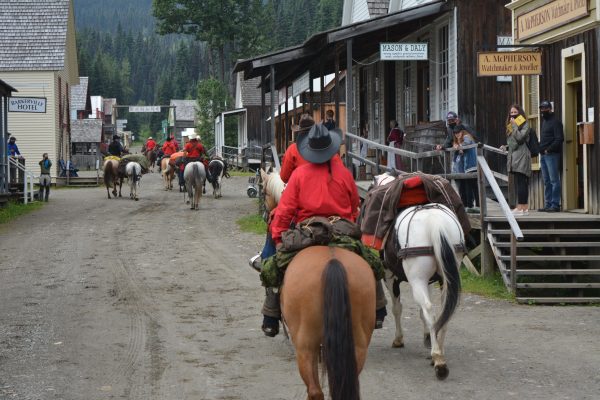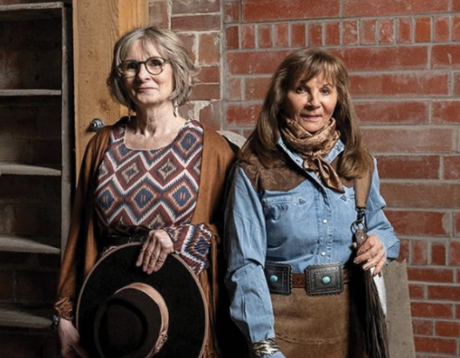 Story and Photos by Lindsay Chung
Story and Photos by Lindsay Chung
For over a century, sure-footed, strong, and ever-watchful horses have carried Canadian soldiers into battle. In central British Columbia, horses are back and play a key role in military operations, helping the Canadian Rangers patrol and protect their local communities.
The Canadian Rangers are a subcomponent of the Canadian Army Reserve who live and work in remote, isolated and coastal regions. They provide lightly equipped, self-sufficient mobile forces to support Canadian Armed Forces (CAF) national security and public safety operations within Canada. They provide local knowledge and expertise and participate in operations, such as search & rescue missions or domestic operations, including wildfire and flood relief activities.

Canadian Rangers must be capable of travelling safely and effectively throughout their area of responsibility by many different means. In B.C.’s Cariboo region, the Quesnel Canadian Ranger Patrol (CRP) is specializing in equine mobility.
The Quesnel CRP, which stood up in 2019, is part of the 4th Canadian Ranger Patrol Group (4 CRPG), covering British Columbia, Alberta, Saskatchewan, and Manitoba.

Before the patrol was stood up, Quesnel CRP Patrol Commander Sergeant Paul Nichols spent several years teaching basic horsemanship to Canadian Rangers and other CAF members. Nichols and his wife, Terry, who is the Quesnel CRP’s second-in command, ran three basic horsemanship exercises with 4 CRPG at their farm in Quesnel, where they trained various CAF Regular Force and Primary Reserve units, as well as members of the Australian Army’s North-West Mobile Force.
Horses are a big part of the Nichols’ lives. In 2015, Paul brought international attention to PTSD when he rode his mare, Zoe, across Canada to raise awareness for young veterans and Post Traumatic Stress Disorder through the Communities for Veterans Foundation Ride Across Canada. (Read Paul’s story, “I Will Keep Riding” in the Oct/Nov 2015 issue of Canadian Cowboy Country.)
Nichols is a former Calgary Highlander, and he served with 2nd Battalion Princess Patricia’s Canadian Light Infantry (PPCLI) during the United Nations mission in the former Yugoslavia in 1993. When his first daughter was born, Nichols left the military, and he and Terry returned to Quesnel.
 |
When Nichols returned from his high-tempo overseas deployment, he spent some time instructing military courses. Years later, his former boss from the battle school played a part in bringing him back into the military as a Canadian Ranger. Nichols has led the Quesnel CRP since it was stood up.
While horsemanship and equine mobility are a key focus for the patrol, the primary role remains to ensure the Canadian military can operate in the area and provide local knowledge.
“Our primary role in the Quesnel CRP still is to be the eyes and ears of the military in our local area,” said Nichols.
The Quesnel CRP currently has 14 members who bring a wide range of horse, life and military experience to the table, including a veterinarian and endurance rider, champion roper, therapeutic riding instructor, helicopter pilot and heavy-duty mechanic.
Canadian Ranger Casey Whittet is the patrol’s farrier. As per military cavalry tradition, the farrier wears black and is easily identifiable. His camp is distinguished by a flag sporting the Rangers’ red and green colours and a gold horseshoe.
Whittet’s grandfather fought in the First and Second World Wars and served with a mounted unit during WWI. “I’ve always been interested in the military and wanted to join when I was young,” said Whittet. “It always fascinated me.”
Along with a wide range of horse experience, the Quesnel Canadian Ranger Patrol has a lot of military experience.
Canadian Ranger Dave Brideau served between 2004 and 2007 as a Mobile Support Equipment Operator with 1 Service Battalion, based out of Canadian Forces Base Edmonton. Brideau continues to serve as a member of the Canadian Rangers and as president of Royal Canadian Legion Branch 139 in Williams Lake, B.C.

Canadian Ranger Cameron Tetreault served from 2001 to 2010 with 3rd Battalion PPCLI at Edmonton Garrison. During his service in 3 PPCLI, Tetreault was part of the amphibious and mountain companies, and he obtained the rank of corporal. Tetreault served in Afghanistan in Op Archer on the provincial reconstruction team in Camp Nathan Smith from July 2005 to February 2006. Tetreault, who now owns a ranch in Quesnel, says he joined the Canadian Rangers to “serve his community and be part of something larger than himself.”
The Canadian military used horses during the First World War before the mechanization of the Canadian Army. Today, outside of the Canadian Rangers, horses are only used in a ceremonial role in Canada by units such as the Governor General’s Horse Guards and Lord Strathcona’s Horse (Royal Canadians).
Nowadays, using horses to get around in domestic operations is one way the Canadian Rangers can preserve skillsets that are being lost as the population becomes more urban.
“Culturally, as Canadians, we are losing touch with our wilderness survival skills, wilderness skills, animal husbandry, even the ability to operate watercraft, and as Canadian Rangers, just by virtue of our geographical locations, these aspects of Canadian life are very familiar to us and are part of our day-to-day existence,” said Nichols. “The military has tapped into that and uses us as one of their tools to preserve a skillset.”

Nichols says in domestic operations, 4 CRPG is the last military unit to use horses in a working role instead of a ceremonial role. Pack animals and saddle horses owned by the individual Canadian Rangers can be used for ground search and rescue operations and long-range patrolling in austere conditions.
“I think the big thing with it is the veneer of civilization is so thin, and when a country falls apart and goes to war, the first thing to happen is the infrastructure crumbles. That means that fuel, parts for equipment and machinery become hard to get, and people are forced to rely on alternate means, whether it’s labour or transportation,” said Nichols. “If you look at photos or talk to people from different conflicts around the world, you always see horses showing up, filling traditional roles. In cases like Afghanistan, where our reconnaissance forces travelled with the locals, they had to travel in the fashion that the locals travel in — which in many cases was on horseback.”
The Canadian Rangers (motto: Vigilans, ‘The Watchers’) has been active since 1942 and have a strong Inuit, First Nations and Métis membership. There are approximately 5,000 active Canadian Rangers across the country.














